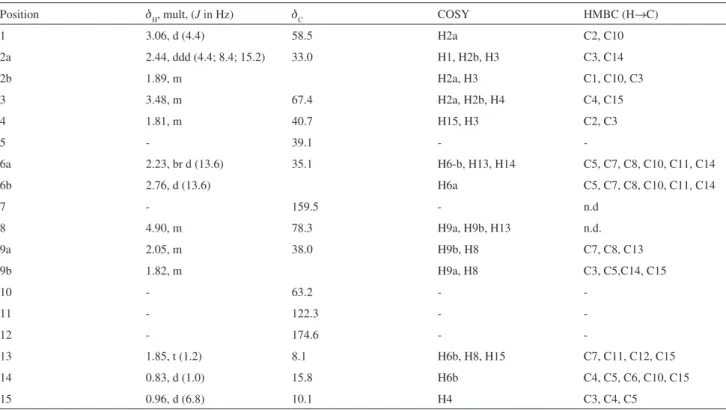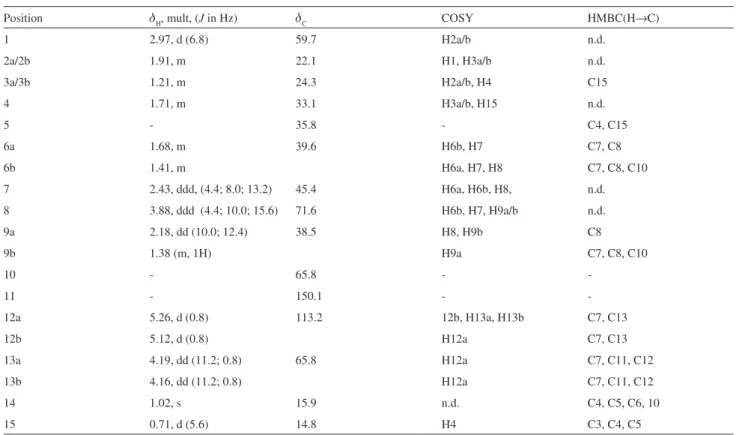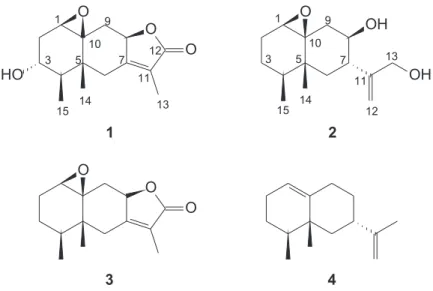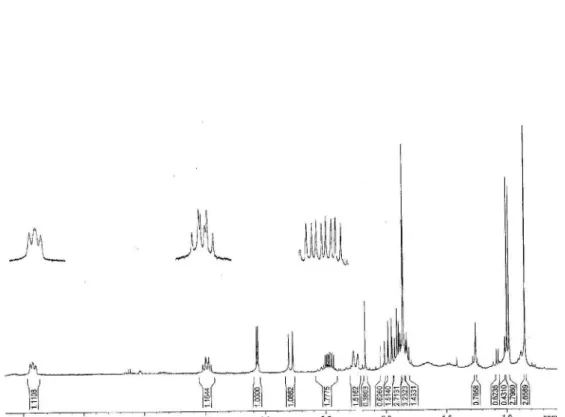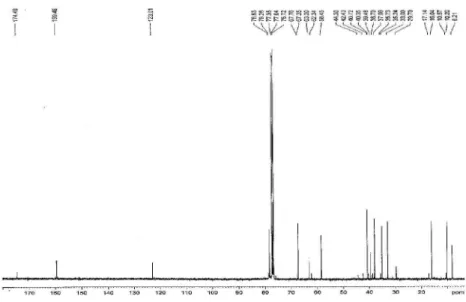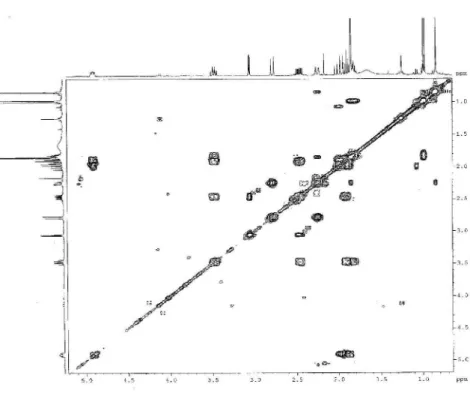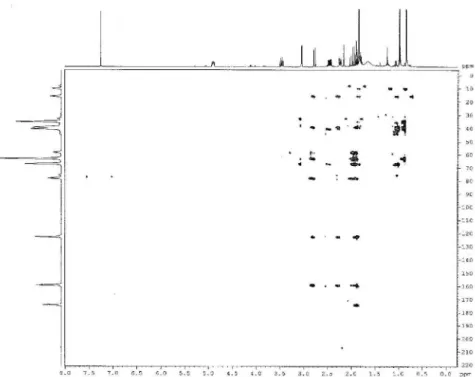Article
J. Braz. Chem. Soc., Vol. 21, No. 8, 1446-1450, 2010. Printed in Brazil - ©2010 Sociedade Brasileira de Química 0103 - 5053 $6.00+0.00
*e-mail: edson@dq.ufscar.br
Two Novel Eremophilane Sesquiterpenes from an Endophytic Xylariaceous Fungus
Isolated from Leaves of
Cupressus lusitanica
Luciana S. Amaral and Edson Rodrigues-Filho*
Departamento de Química, Universidade Federal de São Carlos, CP 676, 13565-905 São Carlos-SP, Brazil
Dois novos sesquiterpenos eremoilanos, cupressolideo A e cupressolideo B, além de dois outros conhecidos, foram isolados a partir do extrato AcOEt do meio de cultura de uma espécie de Xylaria, isolada como fungo endofítico dos tecidos sadios das folhas de Cupressus lusitanica. Estudos espectroscópicos, usando EM e RMN, levaram às estruturas dos dois sesquiterpenos de esqueleto eremoilanos, novos na literatura.
Two new eremophilane sesquiterpenes, cupressolide A and cupressolide B, along with two known sesquiterpenes, has been characterized from the EtOAc extract of a liquid medium where a Xylariaceous fungus, isolated as an endophytic fungus from health tissues of Cupressus lusitanica leaves, was cultivated. The structures of the isolated compounds were determined by analyses of their MS and NMR spectroscopic data.
Keywords:Cupressus lusitanica, Xylaria, eremophilane sesquiterpenes, endophytic fungi
Introduction
Cupressus lusitanica, commonly known as a Mexican Cypress and Portuguese Cypress, belongs to the family Cupressaceae and is usually cultivated as an ornamental tree and in commercial forestry plantation.1,2 Due to its
economic importance, this plant was included in our continuous program established to study the chemistry and biochemistry aspects of plant microorganisms interactions, with emphasis on those apparently symbiotic associations. Among the endophytic fungi isolated from healthy tissues of C. lusitanica leaves, we obtained some strains with macro and micro morphology characteristics of those microorganisms belonging to the genus Xylaria. Besides these morphologic characteristics, Xylaria species are producers of secondary metabolites, including isocoumarin,3,4 cytochalasins,4-6 xanthones,7 xyloketals,8-10
sesquiterpenes,11 that contribute to their classiication in
this genus. In our study we detected isocoumarins and cytochalasins in the fungus extracts using mass spectrometry, which reinforce the hypothesis of its classiication as a Xylareaceous fungus. Among the compounds isolated from the fungus extract, two novel (1 and 2) and two known (3 and 4) eremophilane sesquiterpenes were identiied.
The production of these terpenoids corroborated to classify the fungus within Xylariaceae family. Although it is not clear the importance of these compounds as phytotoxic agents, some members of this class of substances have shown remarkable biological activities, such as anti-inflammatory, antihyperglycemic, cytotoxic, HIV-1 integrase inhibitory.12-15
Results and Discussion
The EtOAc extract of liquid medium from endophytic fungi was chromatographed on silica gel columns to give four compounds (1-4). Compounds 3 and 4 were previously reported in the literature.16,17
Compound 1 was obtained as a colorless crystal. The IR spectrum displayed a broad band at 3487 cm-1
characteristic of a hydroxyl group and a band at 1745 cm-1
attributed to a conjugated γ-lactone. The 13C NMR
spectrum exhibited 15 signals which were assigned, by DEPT 135 and HSQC experiments to three methyls, three methylenes, four methines and three sp2 carbons, one of
this being a carbonyl group. Its ESI-MS spectrum contains an ion peak of [M+H]+ at m/z 265, consistent with the
molecular formula C15H20O4 which also was in accordance with the NMR data. The 1H NMR spectrum of 1 showed
Amaral and Rodrigues-Filho 1447 Vol. 21, No. 8, 2010
CH3-14 and CH3-15, respectively. 1H NMR spectrum
exhibited the presence of a deshielded signal assignable to an oxymethine hydrogen at dH 3.48 (1H, m, H-3); this
signal correlated in COSY spectrum with the dH 1.89 (1H, m, H-2b); 2.44 (1H, ddd, J 15.2; 8.4; 4.4 Hz, H-2a); 1.81 (1H, m, H-4). H-4 showed coupling with the methyl group at dH 0.96 (3H, J 6.8 Hz, CH3-15). The presence of
an epoxy group was conirmed by the chemical shifts of H-1 (d 3.06), C-1(d 58.5), and C-10 (d 63.2).
The COSY spectrum exhibited correlation peaks among the oxymethine hydrogen at dH 4.9 (1H, m, H-8) with
hydrogens at dH 2.05 (1H, m, H-9a); 1.82 (1H, m, H-9b); 1.85 (3H, t, J 1.2 Hz, CH3-13).
HSQC analysis indicated the presence of one tetrasubstituted double bond which was associated with the carbons at dC 159.5; 122.3 (C-7 and C-11, respectively). On the other hand another double bond was observed in the
13C NMR spectrum, with characteristic chemical shifts of
a carbonyl group at dC 174.6 attributed to C-12.
The HSQC spectrum exhibited correlations among the diasterotopic hydrogens at dH 2.23 (1H, br d, J 13.6 Hz,
H-6b) and dH 2.76 (1H, d, J 13.6 Hz, H-6b) with the carbon at dC 35.1. The HMBC spectrum showed coupling of H-6b
with C-5, C-7, C-8, C-10, C-11 and CH3-14. The COSY and HMBC analysis of 1 led to a partial structure as shown in Figure 1.
The relative stereochemistry of 1 was elucidated using nOe and COSY spectroscopy. The β orientation of H-3 was inferred from the nOe correlation with CH3-14 and CH3-15. H-8 (d 4.90) should be α oriented as indicated by the homoallylic coupling with the methyl (CH3-13, d 1.85) bounded to C-11 observed in the COSY experiment. This homoallylic coupling requires a 90º dihedral angle of the methyl group at C-11 with H-6α and H-8, witch was in agreement with the nOe experiment. Furthermore, the nOe spectrum showed correlations of H-6α with H-4 (d 1.81) and of H-6β with CH3-13, CH3-14 and CH3-15. All NMR data are shown in the Table 1.
Compound 2 showed spectroscopic data very similar to those of 1, indicating the presence of an eremophilane skeleton. The IR spectrum displayed a broad band at 3508 cm-1 characteristic of a hydroxyl group. The
Table 1. NMR spectroscopy data for eremophilane sesquiterpene 1a
Position dH, mult, (J in Hz) dC COSY HMBC (H→C)
1 3.06, d (4.4) 58.5 H2a C2, C10
2a 2.44, ddd (4.4; 8.4; 15.2) 33.0 H1, H2b, H3 C3, C14
2b 1.89, m H2a, H3 C1, C10, C3
3 3.48, m 67.4 H2a, H2b, H4 C4, C15
4 1.81, m 40.7 H15, H3 C2, C3
5 - 39.1 -
-6a 2.23, br d (13.6) 35.1 H6-b, H13, H14 C5, C7, C8, C10, C11, C14
6b 2.76, d (13.6) H6a C5, C7, C8, C10, C11, C14
7 - 159.5 - n.d
8 4.90, m 78.3 H9a, H9b, H13 n.d.
9a 2.05, m 38.0 H9b, H8 C7, C8, C13
9b 1.82, m H9a, H8 C3, C5,C14, C15
10 - 63.2 -
-11 - 122.3 -
-12 - 174.6 -
-13 1.85, t (1.2) 8.1 H6b, H8, H15 C7, C11, C12, C15
14 0.83, d (1.0) 15.8 H6b C4, C5, C6, C10, C15
15 0.96, d (6.8) 10.1 H4 C3, C4, C5
aThe data were acquired at 400 and 100 MHz for 1H and 13C respectively in CDCl
3. TMS was used as internal reference.
Two Novel Eremophilane Sesquiterpenes from an Endophytic Xylariaceous Fungus J. Braz. Chem. Soc.
1448
1H NMR experiment exhibited two oleinic hydrogens,
three carbinolic hydrogens and two methyl groups. The EI-MS spectrum of 2 contains an ion peak of M+ at m/z 252, consistent with the molecular formula C15H24O3 and the data observed in the NMR spectrum. The 1H NMR
spectrum of compound 2 exhibited deshielded signals due the presence of oleinic hydrogens at dH 5.26 (1H, d, J
0.8 Hz, H-12a) and dH 5.12 (1H, d, J 0.8 Hz H-12b). The COSY spectrum showed the coupling of H-12a with the carbinolic hydrogens at dH 4.19 (1H, dd, J 11.2; 0.8 Hz, H-13a) and dH 4.16 (1H, dd, J 11.2; 0.8 Hz, H-13b). The
peak attributed to H-8 at dH 3.88 (1H, ddd, J 4.4; 10.0; 15.6 Hz) exhibited correlations in the COSY spectrum with the hydrogens at dH 2.43 (1H, ddd, J 4.4; 8.0; 13.2 Hz, H-7),
dH 2.18 (1H, dd, J 10.0; 12.4 H-9a) and dH 1.38 (1H, m,
H-9b).
The presence of a methine group at dH 1.71 (1H, m,
H-4) was conirmed by COSY correlations at dH 1.21 (1H, m, H-3a) and dH 1.71 (1H, m, H-3b) and dH 0.71 (3H, d, J
5.6 Hz, CH3-15). The signal of CH2-13 (d 4.16 and 4.19), CH3-14 (d 1.02), CH3-15 (d 0.71) and CH2-12 (d 5.12 and 5.26) in the 1H NMR spectrum were in agreement with the
proile of an eremophilane with a double bound at C-11 and C-12. The epoxide group at C-1 and C-10 was deduced from the chemical shifts of H-1 (d 2.97), C-1 (d 59.7), and
C-10 (d 65.8). The COSY analysis of 2 led to a partial structure as shown by bold-faced lines in Figure 2, which were supported by HMBC correlations (Table 2). The relative stereochemistry was based on those determined to compound 2. All NMR data can be observed in Table 2.
Conclusions
The genus Xylaria is known for being a rich source of structurally diverse natural products including isocoumarin,3,4
cytochalsins,4-6 xyloketals,8-10 sesquiterpenes11 and others.
Among these compounds eremophilane sesquiterpenes stand out for several biological activities.12-15 One member
of this genus reported in the present study showed the notable ability to produce eremophilane sesquiterpenes, including two new in the literature, cupressolide A and cupressolide B. Due to the many biological activities shown Figure 2. Selected H-H COSY and HMBC correlations for compound 2.
Table 2. NMR spectroscopy data for eremophilane sesquiterpene 2a
Position dH, mult, (J in Hz) dC COSY HMBC(H→C)
1 2.97, d (6.8) 59.7 H2a/b n.d.
2a/2b 1.91, m 22.1 H1, H3a/b n.d.
3a/3b 1.21, m 24.3 H2a/b, H4 C15
4 1.71, m 33.1 H3a/b, H15 n.d.
5 - 35.8 - C4, C15
6a 1.68, m 39.6 H6b, H7 C7, C8
6b 1.41, m H6a, H7, H8 C7, C8, C10
7 2.43, ddd, (4.4; 8.0; 13.2) 45.4 H6a, H6b, H8, n.d.
8 3.88, ddd (4.4; 10.0; 15.6) 71.6 H6b, H7, H9a/b n.d.
9a 2.18, dd (10.0; 12.4) 38.5 H8, H9b C8
9b 1.38 (m, 1H) H9a C7, C8, C10
10 - 65.8 -
-11 - 150.1 -
-12a 5.26, d (0.8) 113.2 12b, H13a, H13b C7, C13
12b 5.12, d (0.8) H12a C7, C13
13a 4.19, dd (11.2; 0.8) 65.8 H12a C7, C11, C12
13b 4.16, dd (11.2; 0.8) H12a C7, C11, C12
14 1.02, s 15.9 n.d. C4, C5, C6, 10
15 0.71, d (5.6) 14.8 H4 C3, C4, C5
aThe data were acquired at 400 and 100 MHz for 1H and 13C respectively in CDCl
Amaral and Rodrigues-Filho 1449 Vol. 21, No. 8, 2010
by this class of compounds, this Xylaria deserves a careful study aiming to sesquiterpene production enhancement.
Experimental
Equipment
IR spectra were run on a Bomen MB102 -IR spectrometer using KBr pellets. Optical rotation was measured on a Perkin-Elmer 241 polarimeter. GC/MS analyses were performed using GC 8000 series Fisons and VG Platform mass spectrometer detector. 1D and 2D NMR spectra were obtained in CDCl3 (Aldrich) on DRX 400 Bruker spectrometer operating at 400 MHz for hydrogen and 100 MHz for 13C
and TMS was used as internal standard. MS were acquired in positive ion mode on a triple quadrupole Micromass Quattro LC spectrometer, equipped with an ESI ion source.
Plant material
Health leaves of Cupressus lusitanica were collected in São Carlos, São Paulo State, Brazil. A voucher specimen (No. 7281) has been deposited in the Herbarium of the Botanic Department of Universidade Federal de São Carlos, Brazil.
Fungal material
The method of surface sterilization employed in this work was similar to that used by Petrini et al.18 After the
collection, the leaves were washed in abundant water (domestic use grade) and then in distilled water. The leaves were surface sterilization by consecutive immersion in 70% ethanol (2 s), sterile distilled water (2 s), 11% aqueous sodium hypochloride for 1-5 min and 70% ethanol (2 s),
and then in sterile distilled water. The material was placed in Petri dishes containing PDA medium (potato, dextrose and agar) supplemented with 100 μg mL-1 terramicin
and incubated at room temperature. Endophytic fungi growing from the plant tissues, were picked and recultured on PDA to determine culture purity. It was deposited at LaBioMMi – Laboratório de Bioquímica Micromolecular de Microorganismos – of the Departamento de Química at Universidade Federal de São Carlos, Brazil. Working stocks were prepared on potato dextrose agar.
Fermentation and extraction
The fungus was grown under static conditions at room temperature for 20 days in 20 Erlenmeyer lasks containing the liquid medium (300 mL per lask) composed of glucose (26.7 g L-1), yeast extract (10.0 g L-1 ), NaNO
3
(3.0 g L-1), K
2HPO4 (1.0 g L-1), MgSO4•7H2O (0.5 g L-1),
KCl (0.5 g L-1), FeSO
4•7H2O (0.01 g L-1). The mycelium was
separated by reduced pressure iltration and the liquid phase was partitioned with ethyl acetate (1,000 mL × 3). The organic solvent was dried with anydrous sodium sulfate, iltered and removed using vaccum to give the crude extract. Crude extract was analyzed by GC/MS. This technique enabled the detection of the eremophilane sesquiterpene valencene (4). The extract was chromatographed on silica gel columm (h = 4.5 cm and ∅ = 3.7 cm) eluted with a Hex:CH2Cl2 (1:1); CH2Cl2:EtOAc (1:1); CH2Cl2:EtOAc (1:4); CH2Cl2:EtOAc:MeOH (1:4:10%); EtOAc:MeOH (1:1); MeOH (100%) to afford six fractions (A-F). The fractions C and D were rechromatographed on silica gel columm (h = 16 cm and ∅ = 2.5 cm) with Hexane 100% gradient to EtOAc:MeOH (1:1) to give 1 (5.2 mg), 2 (4.8 mg), 3 (2.7 mg).
Two Novel Eremophilane Sesquiterpenes from an Endophytic Xylariaceous Fungus J. Braz. Chem. Soc.
1450
GC/MS analysis
The extract was submitted to clean-up procedures using solid phase extraction (SPE). The SPE cartridge was activated with 100% Hexane and conditioned with 3 mL of CHCl3. The extract (10 mg) was dissolved in 3 mL of CHCl3 and loaded to the SPE cartridge. Elution of SPE cartridge with CHCl3 produced an apolar fraction. For the GC/MS analysis the injector temperature was kept at 180 ºC and the GC oven temperature was maintained at 70 ºC during 6 min and then increased to 250 ºC at a rate of 6 ºC min-1
and inally increased to 325 ºC at 3 ºC min-1. The sample
volume injected was 2 µL.
MS data collection
ESI-MS data were colleted from direct introduction of the sample solution5 µL of compound 1 (5 µg mL-1).
The optimal voltages found for the probe and ion source components to produce maximum intensity of the ions [M+H]+ were 3.3 kV for the capillary, 19 V for the sample
cone, and 4 V for the extractor cone.
Physical and spectral data
(1aR,3R,4R,4aR,8aR,9aS)-3-Hydroxy-4,4a ,6-trimethyl-1a,2,3,4,4aR,8a,9-octahydro-7H-oxirene[8,8a] naphtho[2,3b] furan-7-one, compound 1: Cupressolide A Colorless crystals (CH2Cl2); [α]D25 = −6.262 (c 0.0001,
CHCl3); IR(KBr) νmax/cm-1: 3487, 1745; ESI-MS m/z 265
[M+H]+; ESI-MS-MS (20 eV) m/z 265 (78%), 247 (17),
229 (39), 201 (50), 183 (100), 173 (70), 147 (60), 119 (55); NMR data see Table 1.
(1aR,4S,4aR,6S,7R,8a S)-6-[1-(Hydroxymethyl)vinyl]-4,4a-dimethyloctahydro-1aH-naphtho[1, 8ab]oxiren-7-ol, compound 2: Cupressolide B
Colorless crystal (CH2Cl2); IR(KBr) νmax/cm-1: 3508;
EIMS (70 eV) m/z 252 [M]+ (3%), 234 (6), 216 (12), 201
(16), 168 (57), 153 (75), 125 (100); NMR data see Table 2.
Supplementary Information
Supplementary data are available free of charge at http://jbcs.sbq.org.br, as PDF ile.
Acknowledgments
The autors are gratefull to the Brazilian institutions FAPESP – Fundação de Amparo à Pesquisa do Estado de
São Paulo, CNPq – Conselho Nacional de Desenvolvimento Científico e Tecnológico, CAPES – Coordenação de Aperfeiçoamento de Pessoal de Ensino Superior for the inancial support.
References
1. Farjon, A.; Taxon1993, 42, 81.
2. Graniti, A.; Annu. Rev. Phytopathol. 1998, 36, 91.
3. Tansuwan, S.; Pornpakakul, S.; Roengsumran, S.; Petsom, A.; Muangsin, N.; Sihanonta, P.; Chaichit N.; J. Nat. Prod.2007,
10, 1620.
4. Pongcharoen, W.; Rukachaisrikul, V.; Isaka, M.; Sriklung, K.;
Chem. Pharm. Bull.2007, 55, 1647.
5. Espada, A.; Rivera-Sagredo, A.; de la Fuente, J. M.; Hueso-Rodríguez, J. A.; Élson, S. W.; Tetrahedron1997, 53, 6485.
6. Abate, D.; Abraham, W.; Meyer, H.; Phytochemistry1997, 44, 1443.
7. Healy, P. C.; Hocking, A.; Tran-Dinh, N.; Pitt, J. I.; Shivas, R. G.; Mitchell, J. K.; Kotiw, M.; Davis, R. A.; Phytochemistry
2004, 65, 2373.
8. Lin, Y.; Wu,X.; Feng, S.; Jiang, G.; Luo, J.; Zhou, S.; Vrijmoed, L. L. P.; Jones, E. B. G.; Krohn, K.; Steingröver, K.; Zsila, F.;
J. Org. Chem.2001, 66, 6252.
9. Xiaobo, Z.; Haiying, W.; Linyu, H.; Yongcheng, L.; Zhongtao,
L.; Process Biochem.2006, 41, 293.
10. Liu, X.; Xu, F.; Zhang, Y.; Liu, L.; Huang, H.; Cai, X.; Lin, Y.; Chanb W.; Russ. Chem. Bull. 2006, 55, 1091.
11. McDonald, L. A.; Barbieri, L. R.; Bernan, V. S.; Janso, J.; Lassota, P.; Carter G. T.; J. Nat. Prod.2004, 67, 1565.
12. Wang, W.; Gao, K.; Jia, Z.; J. Nat. Prod. 2002, 65, 714. 13. Garduño-Ramírez, M. L.; Trejo, A.; Navarro, V.; Bye, R.;
Linares, E.; Delgado, G.; J. Nat. Prod. 2001, 64, 432. 14. Li, E.-W.; Pan, J.; Gao, K.; Jia, Z.-J.; Planta Med. 2005, 71,
1140.
15. Zhang, Q. J.; Dou, H.; Zheng, Q. X.; Zhou, C. H.; Xu, Z. J.; Peng, H.; Zhao, Y.; Chin. Chem. Lett. 2005, 16, 360.
16. Zhao Y.; Schenk, D. J.; Takahashi, S.; Chappell, J.; Coates, R.
M.; J. Org. Chem. 2004, 69, 7428.
17. Prez-Castorena, A. L.; Arciniegas, A.; Guzmn, S. L.; Villaseor, J. L.; de Vivar, A. R.; J. Nat. Prod. 2006,69, 1471.
18. Petrini, O.; Sieber, T. N.; Toti, L.; Viret, O.; Natural Toxins
1992, 1, 185
Received: June 25, 2009 Web Release Date: March 25, 2010
Supplementary Information
J. Braz. Chem. Soc., Vol. 21, No. 8, S1-S6, 2010. Printed in Brazil - ©2010 Sociedade Brasileira de Química 0103 - 5053 $6.00+0.00
*e-mail: edson@dq.ufscar.br
Two Novel Eremophilane Sesquiterpenes from an Endophytic Xylariaceous Fungus
Isolated from Leaves of
Cupressus lusitanica
Luciana S. Amaral and Edson Rodrigues-Filho*
Departamento de Química, Universidade Federal de São Carlos, CP 676, 13565-905 São Carlos-SP, Brazil
Two Novel Eremophilane Sesquiterpenes from an Endophytic Xylariaceous Fungus J. Braz. Chem. Soc.
S2
Figure S2.13C NMR spectrum of compound 1 (100 MHz, CDCl 3).
Amaral and Rodrigues-Filho S3 Vol. 21, No. 8, 2010
Figure S5.1H-13C HSQC 2D NMR correlation spectroscopy of compound 1 (400 MHz/100 MHz, CDCl3).
Two Novel Eremophilane Sesquiterpenes from an Endophytic Xylariaceous Fungus J. Braz. Chem. Soc.
S4
Figure S6.1H-13C HMBC 2D NMR correlation spectroscopy of compound 1 (400 MHz/100 MHz, CDCl 3).
Amaral and Rodrigues-Filho S5 Vol. 21, No. 8, 2010
Figure S9.1H-1H COSY NMR correlation spectroscopy 2D NMR spectrum of compound 2 (400 MHz, CDCl 3).
Two Novel Eremophilane Sesquiterpenes from an Endophytic Xylariaceous Fungus J. Braz. Chem. Soc.
S6
Figure S10.1H-13C HSQC 2D NMR correlation spectroscopy of compound 2 (400 MHz/100 MHz, CDCl3).
